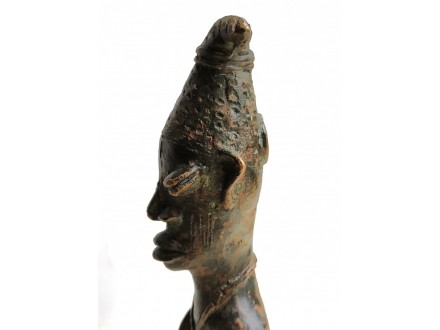afrika BENIN - figura ratnika - bronza 19 vek?
| Cena: |
| Želi ovaj predmet: | 14 |
| Stanje: | Polovan sa vidljivim znacima korišćenja |
| Garancija: | Ne |
| Isporuka: | Pošta Post Express |
| Plaćanje: | Tekući račun (pre slanja) PostNet (pre slanja) |
| Grad: |
Beograd-Stari grad, Beograd-Stari grad |
Kulturno dobro: Predmet koji prodajem nije kulturno dobro ili ovlašćena institucija odbija pravo preče kupovine
25 x 6 x 5 cm, tezina oko 1kg
nedostaje postolje
ne garantujem period (deluje dosta staro,mozda cak i 18 vek)
samo srbija
ovaj predmet ne saljem u inostranstvo
Kraljevstvo Benin bila je pretkolonijalna afrička monarhija na području današnje države Nigerije. Kraljevstvo nema nikakvih veza sa današnjom modernom državom Benin.
Pre 7. veka naše ere, istorija crne Afrike je slabo poznata. Tokom evropskog srednjeg veka, razvijaju se velike kraljevine. Nalazile su se južno od Sahare, pored velikih reka. U 14. veku nijedno od ovih kraljevstava, ne uspeva da se odupre dominaciji Evrope.
Narodi crne Afrike su trgovali sa Berberskim stanovništvom, koje živi u severnoj Africi. Roba kao na primer so, zlato, plod kole... prelazila je preko pustinje na leđima kamila. Između 5. i 11. veka Kraljevstvo Gana, zasniva svoju privredu na trgovini. Ali u 11. veku narodi sa severa, koji su prešli u islamsku veru, počinju sa osvajanjem ovog dela Afrike. Tako nastaju muslimanske države u crnoj Africi.
Kraljevstvo Benin je ostalo po strani muslimanskih osvajanja. Nastalo je u 12. veku, a u 15. veku se proteže od oblasti Lagosa do reke Niger. U ovom periodu umetnost u Beninu, a posebno umetnost livenja bronze, dolazi do vrhunca.
Grad Benin je raskošna prestonica, koja pokazuje moć carstva. Palata je bila pretrpana umetničkim delima, a posebno su bile poznate Obine glave, izlivene u bronzi.
Šanac i dupli bedem od stabala, štitili su ovaj grad. Iza zida jednospratne kuće, obrazovale su ulice. Svaki deo grada je bio rezervisan za jedno zanimanje. Na primer vajari u slonovači, drvorezci, kožari, kovači, livci bronze...
Vladar kraljevine Benin je bio oba. Smatralo se da je umetnost samo obina privilegija. Jedino je on smeo da nosi koralne ogrlice. Umetnici nisu smeli da liju bronzu, ili vajaju u slonovači bez njegove dozvole. Metal je simbolizovao monarhiju, a slonovača čistotu. U palati su se nalazile maske i figure od drveta, slonovače i bronze.
U 14. veku jedan livac iz susednog grada Efe dolazi u Benin, da podučava svojoj tehnici livenja bronze, livce u Beninu. Njegova tehnika livenja bronze je izgledala ovako:prvo se oblikuje lice u glini, a zatim se prekriva tankim slijem voska, pa se ponovo prekriva glinom. Figura bi se ostavila da se peče. Kada se vosak istopi tokom pečenja, livac popunjava šupljinu gde se nalatio vosak tečnom bronzom. Nakon što se kalup ohladi, livac ga oprezno razbija, da ne bi oštetio bronzu. I na kraju kada se kalip razbije, pojavljujese bronzana glava.
-----------------------------------------
Art of the Kingdom of Benin
Benin art is the art from the Kingdom of Benin or Edo Empire (1440–1897), a pre-colonial African state located in what is now known as the South-South region of Nigeria. Primarily made of cast bronze and carved ivory, Benin art was produced mainly for the court of the Oba of Benin - a divine ruler for whom the craftsmen produced a range of ceremonially significant objects. The full complexity of these works can be appreciated only through the awareness and consideration of two complementary cultural perceptions of the art of Benin: the Western appreciation of them primarily as works of art, and their understanding in Benin as historical documents and as mnemonic devices to reconstruct history, or as ritual objects. This original significance is of great importance in Benin.
The royal arts of the Benin Kingdom of south-central Nigeria affirm the centrality of the oba, or divine king, portraying his divine nature. While recording the kingdom`s significant historical events and the oba`s involvement with them, they also initiate the oba`s interactions with the supernatural and honor his deified ancestors, forging a continuity that is vital to the kingdom`s well-being.
The materials used in Benin`s royal arts—primarily brass, ivory, and coral—are endowed with sacred power. The innate value of these materials within Benin and the time and skill that is invested in working them reflect the earthly and otherworldly influence of the oba and the great wealth of his kingdom. Benin`s royal arts belong to a tradition that favors convention even as it promotes creativity and innovation, especially as a reflection of royal prerogative. Through time, rulers have used the arts to interpret the history of the kingdom and to orient themselves with the past in an effort to support their own initiatives and define their images for posterity.
Although only popularly known to Western audiences after the Benin Expedition of 1897, Benin art has been in existence since at least the 13th century.
A newly installed oba is responsible for creating an altar dedicated to his father, commissioning the appropriate objects to adorn it and activating it on a regular basis with sacrifices of food or animal blood. The oba does the same for his mother if she attained the title of iyoba, or queenmother. While bells and rattle staffs are placed on all ancestral altars, ivory tusks and commemorative brass heads are made specifically for royal altars. Associated with trade, ivory and brass are durable and valuable, and their colors—white like sacred kaolin clay and red like fire and coral beads—relate to royal power.
Before the British conquest, an oba`s courtyard was the focal point for rituals in his honor. British troops reported 18 altars dedicated to previous obas when they took possession of the palace in 1897. Today, all of the royal altars stand together in a single courtyard.
One of the objects unique to Benin art is an Ikegobo, or `altar to the hand,` which celebrates the accomplishments of exceptional individuals. The hand is associated with action and productivity, and is considered the source of wealth, status, and success for all those who depend on manual skill and physical strength. Altars of this kind are commissioned in terracotta, wood, or brass, depending on the status of the patron.
Private and public ceremonies mark many of the important moments in Benin`s yearly calendar. In the past, an elaborate series of rites were performed throughout the year to secure otherworldly support for the kingdom`s well-being and to celebrate decisive events in its history. For the sake of convenience, the current monarch, Oba Ewuare II, emphasizes the end-of-year festival called Igue, which is held during the winter holidays to allow the greatest number of people to attend. Igue includes a sequence of rituals that renew the oba`s supernatural powers and cleanse the kingdom`s unruly spirits.
Benin`s other important ritual festivals include Ague, where the first budded yams are blessed in hopes of a successful harvest; Ugie Ivie, the Festival of Beads, in which the oba`s coral and red stone regalia is bathed in cow`s blood to reinvest it with spiritual force; Ugie Erha Oba, which honors the oba`s father and all paternal ancestors; Oduduwa, a masquerade that likewise honors the oba`s paternal ancestors; and Ugie Oro, celebrating Oba Esigie`s victory over the Idah Kingdom in the 16th century.
Finely carved ivory double gongs are examples of art related to rituals at court. They are called “double” gongs because of second, smaller resonating cups at their front. Typically, the central image is the oba in coral regalia supported by the high priests osa and osuan, officials who tend the altars of the kingdom`s two patron gods. These gongs are still carried today by the oba during Emobo, the last of the empowering rites of the Igue festival. The oba gently taps the ivory instrument, creating a rhythmic sound to calm and dismiss unruly spirits from the kingdom.
The oba is referred to metaphorically as “the leopard of the house,” and images of the beautiful, cunning, and immensely dangerous cat appear frequently in Benin`s royal arts. Before the British invasion in 1897, domesticated leopards were kept in the palace to demonstrate the oba`s mastery over the wilderness. Leopard imagery is also frequently linked to the oba`s military might.
The oba`s divine right to rule is reiterated in his regalia. His coral crowns, shirts, aprons, necklaces, and accessories refer to those that Oba Ewuare is said to have stolen from Olokun, the god of the waters and prosperity. Coral and red stones such as jasper and agate are also filled with supernatural energy, or ase, as are elephant ivory and brass, two other valuable materials that the oba has historically controlled.
Despite his divine status, the oba can not rule alone. He must rely on others to fulfill his destiny, a dependence that is physically expressed when he walks or sits with his arms supported at the elbows and wrists by attendants. They help him bear the weight of his regalia, a constant reminder of the burden of kingship.
Brass casters (igun eronmwon) are the highest-ranking craft guild within the hierarchical structure of the Iwebo society, followed by blacksmiths (igun ematon) and ivory and wood carvers (igbesanwan).
The origins of brass casting in Benin are debated. One popular story credits Oba Oguola (enthroned c. 1280) with sending for a master brass caster from Ile Ife, the capital city of the ancient Ife Kingdom to the northwest, and with later establishing a royal brass-casting guild. Others suggest brass casting developed independently in Benin and may have mutually benefited from exchange with Ile Ife. Casters in both regions used the lost wax method, in which a precisely detailed wax model is formed over a clay core. When the model is complete, clay is carefully applied over the wax. It is then heated, melting the wax, which exits from a narrow channel. Next, molten metal is poured into the mold. Once cool, the hardened clay is chipped away, leaving behind an image now cast in bronze.
The decline of Benin art occurred at the end of the 19th century when the Benin Expedition of 1897 [6]by the British caused impairment in the creation of the arts. On February 18, 1897, the British arrived in Benin City to punish a massacre. The possessions of the oba and his court became spoils of war. The objects were rounded up with little regard for their associated meaning; no systematic record was kept of their grouping or placement. Many of these objects were sold in London to defray the cost of the expedition.
MOLIM CENJENE KUPCE DA ISPOSTUJU PRAVILNIK(ROKOVE) LIMUNDO-KUPINDO TIMA.
ne dajem nikakve popuste.
izlozene cene su KONACNE, bez obzira na kolicinu
NE RAZNOSIM PRODATU ROBU - OVO VAZI I ZA BEOGRAD.
licno preuzimanje predmeta na mojoj adresi (ispred zgrade), posle 18h
naravno, u roku koji se dobije posle prodaje.
placanje na tekuci racun u POSTI - POSTANSKA STEDIONICA
INO KUPCI -- paypal (+5%) (pitati za postarinu)
INTERNATIONAL BUYERS WELCOME
IF YOU HAVE ANY QUESTION REGARDING CONDITION,SHIPPING AND PRICING PLEASE EMAIL US BEFORE YOU BID. THANK YOU !
NOVAC U PISMU - NE PRIMAM.
slanje POSTEXPRESOM (ili VREDNOSNO PISMO)
ako stoji `besplatna dostava`(pored broja pregleda) onda VAZI SAMO ZA SRBIJU
POUZECEM -- N E S A L J E M
komunikacija iskljucivo preko limundo-kupindo poruka
slike se najbolje vide kada se klikne na `Slika u punoj veličini`
Predmet: 66915545

















